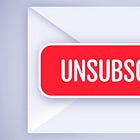Substack Weekend Musings #2
The latest weekly roundup of everything worth knowing, reading and discovering on Substack this week.
Welcome to the second edition of GYN’s Substack Weekend Musings!
As a reminder, this (mostly) weekly roundup will share a load of things worth knowing if you’re growing a newsletter on Substack (or even if you’re just an active user).
A catch-up on recent posts here, some of my favourite reads from other writers and news about the platform, as well as other bits and pieces worth knowing.
✉️ What’s in today’s edition?
💰 Thoughts on controversial Substack creators
👀 What you might have missed from GYN
🗳️ The first weekly poll
📚 My three favourite reads this week
🛠️ A Substack strategy I’m thinking about
This week on Substack 📰
Not everyone on Substack is enjoying themselves. Well, perhaps most of us are. The ones who aren’t happy will generally end up leaving.
I am curious about one common complaint I’ve seen recently: that Substack is allowing fascists and far right extremists to publish freely, effectively platforming them. But I don’t function in those spaces, and my feed is curated in such a way that I almost never come across problematic content.
So I’m curious. To what extent does who Substack ‘platforms’ bother you? I’d like there to be limits, but isn’t the basis for this platform that it is, in its most basic form, a place to write a blog and email subscribers? Should you choose, you can do that and virtually nothing else. And you can easily move your entire list of subscribers elsewhere should you choose.
Problematic creators haven’t concerned me a great deal. One, I simply ignore them. Two, they’re on every other platform as well. In certain cases, I’d prefer Substack took action and banned certain people. But once you go down that route, it can become a slippery slope to censorship of any view you deem unacceptable.
I’m not suggesting that Substack allow Nazis to spew hate freely to all who’ll listen, but I would prefer caution when it comes to banning accounts.
And I want to know what you think. Should Substack be doing more to remove potentially harmful political views? As someone not in those spaces, and not reading anything from those creators, perhaps I’m unaware of how bad things really are. Let me know your thoughts!
Missed anything from GYN? 👀
This week I shared two new posts with you all: Three key things to consider before you start monetising your content, and a thoughtful piece about whether unsubscribes are really as bad as they feel.
Poll of the week 🗳️
I want to know how long you have been using Substack for.
By all accounts, Substack is growing rapidly, with more users and more paid subscribers every single month. But how long have you been around? I’m curious to know how new the platform is to you, and to what extent you’ve seen it change since you arrived.
I’ve been here for just under two years now, and just in that span I’ve seen lots change already. As always, still excited to see what the future holds here!
My top three reads this week 📚
This week, I asked for recommendations from you via the Substack chat. You shared some amazing work, and I’ve enjoyed taking the time to read through and see what you’re all working on.
Here are three of my favourites:
I loved this piece by Dani Nichols about kids literature. It’s a really insightful view into why imaginative and creative storytelling is important. It gets at something that many writers of children’s fiction forget: children’s stories don’t need to perfectly mirror the hardest realities of life. They have all of adulthood for that!
Children love stories that stretch their imagination, spark courage and show them excitement. The best children’s books teach not with lectures, but by sharing truly delightful, creative work. This piece was a great read, especially for any of you out there writing children’s books right now.
I really enjoyed this piece by Jennifer Houle which dives into the nonsense that many companies use under the banner of ‘wellness’. It’s sharp, honest, and embedded in reality. I think we’re all familiar with how surface-level solutions are used, often to patch over deeper dysfunction within an organisation!
I’m familiar with many a ‘pizza party’ that usually involves a slice or two (if lucky) of cold pizza, alongside a non-alcoholic drink from a plastic cup. What could be better for employee wellness than that?
Finally, I really enjoyed reading this post from Carly Bush. It’s gentle and honest, and really makes you think about how it feels to be stuck in a creative limbo, especially when significant life events take their toll. It’s a lovely reflective piece, and reminds us that sometimes the best thing to write is just whatever brings us peace.
A Substack strategy I’m thinking about 🛠️
I go backwards and forwards a lot on pricing when it comes to Substack. How to know what to charge? Until I started the FWN nearly two years ago, I’d never had to consider charging for something unless I was selling my old clothes on Vinted.
So now, with everything that I offer across my two newsletters, I’m often thinking about pricing and value for money. Given Substack take 10% of every fee, Stripe takes 3% plus $0.30 from every individual transaction, it doesn’t take long before a subscription fee looks a little thin when it arrives in the account.
So what is fair pricing? And how do you decide what your newsletter is worth? I sometimes base mine on what similar newsletters are offering, so that I can ensure I’m competitive within the market. But if I believe my content is the best, as I do (else I wouldn’t be doing this), is that fair value?
The difficulty with newsletter subscriptions is that you need hundreds of paid subscribers to compensate you for your time. Even fewer than 100 paid readers will most likely work out at less than minimum wage. That’s fine—amazing even—if it’s a hobby, but what if you’re trying to devote more time to the work? We all need to make a living in some way or another.
Let me know your thoughts. How do you decide to price the paid section of your newsletters?
Any thoughts? 💬
Let me know if you have anything to say on anything from today’s Substack Weekend Musings. I always love to hear from you!







I haven't seen any problematic posts myself. Won't banning problematic posts make the posters and their content more popular? I'm wondering if it would be better to let them post their garbage and voice our opinions in their comment sections—just my opinion.
The problem with this is that you are, fundamentally, in those spaces, in that Substack benefits more from network effects than you do. Anil Dash suggests people unpack this las year in his essay Don't Call It a Substack https://www.anildash.com/2024/11/19/dont_call_it_a_substack/
When people use specific kinds of features, like monetizing or community features, it's easy to believe that the benefit of being on a particular platform outweighs any concerns you may have about its content policies. Then occasionally, flagrant hate speech is exposed ( https://www.theatlantic.com/ideas/archive/2023/11/substack-extremism-nazi-white-supremacy-newsletters/676156/?gift=j9r7avb6p-KY8zdjhsiSZ1RLcOPmvywfPzJWyac8ltI ), or Substack sends a push message recommending an expressly Nazi newsletter ( https://www.usermag.co/p/substack-sent-a-push-alert-promoting-nazi-white-supremacist-blog ). As long as people shrug and say "content moderation is a slippery slope," this will keep happening.
People do move their newsletters off Substack and sometimes find that they save money in the process. In the meantime, Substack is eager to social-media-fy its site as much as it can, so you think the network effects are good to pass up.
I am not castigating anyone who stays. There are lots of reasons to do things one way or another. It's just important to be thoughtful about whose pockets we help line.